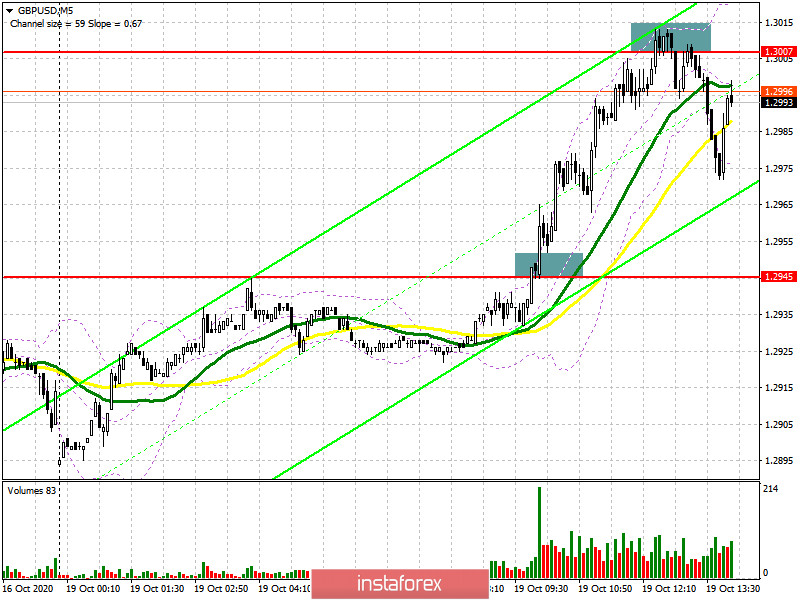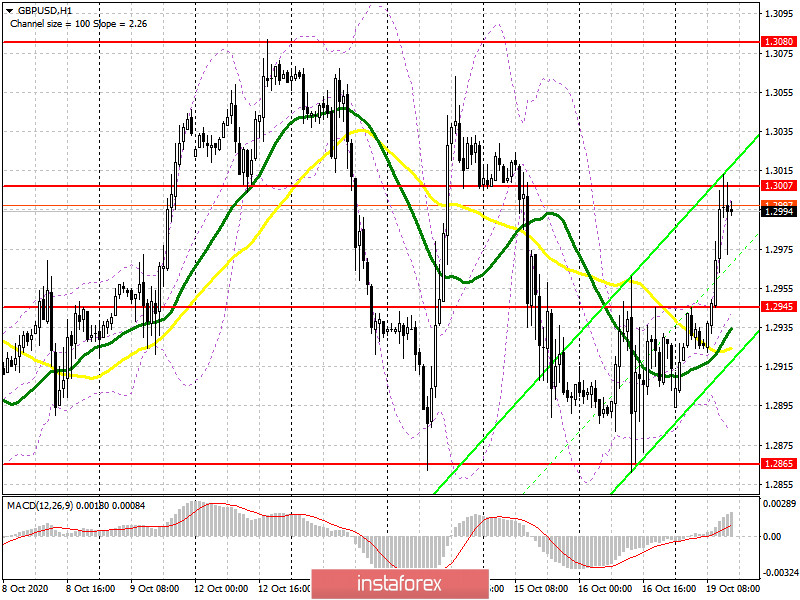To open long positions on GBP/USD, you need:
In the first half of the day, I paid attention to buying the pound above the resistance of 1.2945. Let's take a look at the 5-minute chart and analyze the entry points to the market. We see how the breakout of 1.2945 led to the formation of a good upward wave of the pound, however, this transaction passed by, as the reverse test of the level of 1.2945 from top to bottom did not take place. But if you didn't have time to buy the pound, you could always sell it on a false breakout from the resistance level of 1.3007. We see how the bulls climb above 1.3007 for a while, but then the pair returns to this level, and the next attempt to break 1.3007 turns out to be unsuccessful, which forms a signal for the passage of the pound, which brings more than 40 points of profit on the first movement.

The second half of the day is also poor in fundamental statistics, thus, the emphasis will be placed on the technical component. Bulls now need a breakout and consolidation above the resistance of 1.3007, which opens a direct road to the area of the local maximum of 1.3080, where I recommend fixing the profits. However, a more correct entry point for long positions on the pound will be from the support of 1.2945, above which it was possible to break through today in the first half of the day. You can buy from this level immediately for a rebound based on a correction of 20-30 points within the day. If there is no bull activity at the level of 1.2945, I recommend that you postpone long positions until the low of 1.2865 is updated.
To open short positions on GBP/USD, you need:
In the second half of the day, sellers need to protect the resistance of 1.3007, which has already been tested and from which a good sell signal for the pound was formed. As long as trading is conducted below this range, the probability of GBP/USD returning to the support area of 1.2945 will remain quite high. Another false breakout formation at this level forms an additional entry point for short positions. An equally important task for the bears will be to return the pound to the support of 1.2945, which will increase pressure on the pair and lead to an update of the minimum of 1.2865. If the growth of GBP/USD continues above 1.3007, it is best not to rush with sales, but wait for the test of the maximum of 1.3080 and sell the pound from there immediately on the rebound in the calculation of 20-30 points of correction at the first touch.

Let me remind you that in the COT reports (Commitment of Traders) for October 13, there was a reduction in both long and short non-commercial positions. Long non-commercial positions declined from a level of 40,698 up to the level of 36,195. At the same time, short non-commercial positions fell more significantly from the level of 51,996 to the level of 45,997. As a result, the negative value of the non-commercial net position slightly increased to -9,802, against -11,298 a week earlier, which indicates that sellers of the British pound remain in control and have a minimal advantage in the current situation.
Signals of indicators:
Moving averages
Trading is conducted above 30 and 50 daily averages, which indicates an active attempt by the bulls to take control of the market.
Note: The period and prices of moving averages are considered by the author on the hourly chart H1 and differ from the general definition of classic daily moving averages on the daily chart D1.
Bollinger Bands
If the pair declines, support will be provided by the average border of the indicator in the area of 1.2945, from which you can buy the pound immediately for a rebound.
Description of indicators
- Moving average (moving average determines the current trend by smoothing out volatility and noise). Period 50. The graph is marked in yellow.
- Moving average (moving average determines the current trend by smoothing out volatility and noise). Period 30. The graph is marked in green.
- MACD indicator (Moving Average Convergence / Divergence - moving average convergence / divergence) Fast EMA period 12. Slow EMA period 26. SMA period 9
- Bollinger Bands (Bollinger Bands). Period 20
- Non-profit speculative traders, such as individual traders, hedge funds, and large institutions that use the futures market for speculative purposes and meet certain requirements.
- Long non-commercial positions represent the total long open position of non-commercial traders.
- Short non-commercial positions represent the total short open position of non-commercial traders.
- Total non-commercial net position is the difference between the short and long positions of non-commercial traders.





















